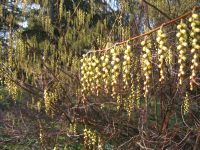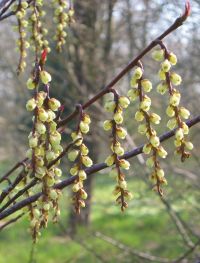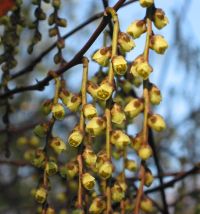Spiketail - Stachyurus praecox
English name:
Spiketail
Scientific name:
Stachyurus praecox
Family:
Stachyuraceae
Height:
to 2.5 M in Hørsholm
Flowering:
Mid April to early May
Range:
Japan
 |
|
 |
 |
The Stachyurus praecox in the pictures are from seed collected by the Nordic Arboretum Committee expedition to Japan in 1976. The seed was collected on the symmetrical Mt. Daisen volcano on the Island of Honshu, Shimane prefect. They can be found in square 1408 positions 1134 to 1239 near the Arboretums collection of European and west Asian conifers. A map with squares and positions can be found on our homepage under: Plant search.
Plant description:
Our cold spring has delayed flowering of different taxa by 2 to 4 weeks in comparison to previous years. Normally I would not think of having the early flowering Stachyurus praecox as a plant for the month of May but this is what is in flower in the first week of May.
The genus Stachyurus is composed of 5 to 6 species. We have two of these in our collection. The genus gets its name from the hanging flower spikes (Stachy = spike, orua = tail). The natural range of the genus is from the Himalayas to Japan. The genus is placed in its own family, Stachyuraceae after being placed in several other families including Theaceae. Rather uncommon outside of botanic gardens and specialist collections it deserves more attention. Interestingly an American has written that is it not sold much because it flowers before most people think of gardening and start to visit their local nurseries in the spring. Although often killed by frost we have some individuals that have survived for 29 years in our collection. Thus, Stachyurus praecox nevertheless has potential if one find the right type or provenance. We recently held a guided tour of the Arboretum with the theme early flowering plants. Spiketale was the plant that made the biggest impression, perhaps in part because most people had not seen it before.
We have 5 examples of Stachyurus praecox at the Arboretum. All are from seed collected in the wild during the Nordic Arboretum Committees expedition to Japan in 1976. Three plants are from Mt. Daisen in Shimane Prefect on the island of Honshu and the other two plants are from Mt. Tateyama in the Toyama Prefect of Honshu. Both accessions were collected at about 1000 m elevation.
Stachyurus praecox is endemic to Japan. It was referred to in Danish literature first in 1916, 20 years before the founding of the Hørsholm Arboretum. Our first introduction to the Arboretum was in 1953. This first introduction has not survived and all of our living plants are from the Nordic Arboretum Expedition to Japan in 1976.
These are upright, deciduous shrubs about at wide as tall. The branches are hairless, red-brown, shinny and arch over to the sides. The leaves are elliptic or egg-lanceolate formed with a long drawn out tip and a rounded base. The edges of the leaves are saw-toothed. The flowers open before leaf unfolding (like all of the early-flowering plants in the Arboretum). The flowers are bisexual, bell shaped, and the petals are not fused. They are yellow and are on long inflorescences in April and May in Hørsholm. The flower spikes look delicate but if one turns the branches upside down the flower spikes stick strait up. The fruit is a small 4 chambered leathery berry with many seeds. We have not recorded fruiting on our plants.
Plants in our collection were named by Niels Jensen in 1994 as plants worth propagating. The species is described in Plants that Merit Attention as one of the finest, early-flowering shrubs. It has won awards from the Royal Horticultural Society. The delicate yellow flowers contrast well with the reddish twigs. They are best seen against a dark background, like a group of evergreen conifers or holly bushes. Propagation is by seed, layering or rooted cuttings. Several named cultivars exist. Pests and diseases are uncommon, but some cultivars or provenances are killed by freezing in the Danish climate.
References:
Bean, W.J. 1980 Trees and Shrubs Hardy in the British Isles Vol IV. Ri.-Z. John Murray publishers. 808 pp.
Houtman, R.T. 1996. Stachyurus Staartaar. Dendroflora 33:129-138
Jensen, N. 1994. Guide til Arboretet i Hørsholm. Dansk Dendrologisk Forening publ. 237 pp.
Lange, J. 1999. Kulturplanternes Indførselshistorie i Danmark indtil midten af 1900-talet. (Introduction History of Cultivated Plants in Denmark up to the middle of the 20th century). DSR Forlag, Frederiksberg C. 458 pp.
Mabberley, D.J. 1998. The Plant Book. The Bath Press, Bath, 858 pp.
Olsen, O. et al. 1997 Havens Planteleksikon. Træer og Buske. (Danish Plant Encyclopedia, Trees & Bushes). Det Danske Haveselskab Publisher, 674 pp.
Poor, J.M. & Brewster, N.P. 1996. Plants that merit attention. II. Shrubs. Timber Press Inc. Portland.
